Tabernemontana
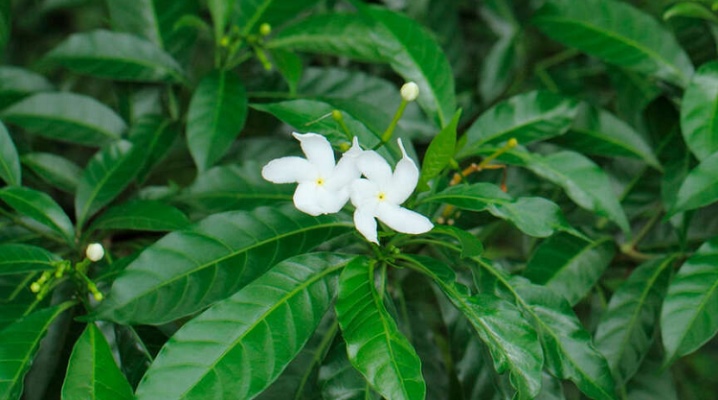
Tabernemontana is a flower from the group of decorative flowering evergreens, suitable for growing at home. The difficult to pronounce name is a characteristic feature of the flower. The rest of the plant is an attractive little shrub covered with white double and fragrant buds. It is worth considering in more detail the features of growing this plant and caring for it.
Description
Tabernemontana got its complex name thanks to the Frenchman Charles Plumier, who, in turn, named the flower in honor of the scientist from Germany - Jacob Dietrich Müller. It is interesting that he did not like his surname, and soon he began to work under the pseudonym Tabernemontanus, which is why the flower has such a difficult to pronounce name.
For the first time the flower was discovered in India, Singapore and Ceylon are also considered the birthplace of the plant, where the bush is found almost everywhere. The second name of tabernemontana is “flower of love”. Today the bush is found in:
- Africa;
- Central America;
- South America.

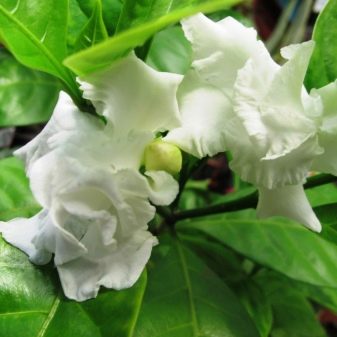
In these areas, the flower is grown as an outdoor ornamental crop. In Russia, tabernemontana is planted at home, furnishing various rooms with attractive shrubs. Tabernemontana belongs to a group of plants from the Kutrovye family and is considered a close relative of oleander, with which the bush is often confused. Also, externally, tabernemontana resembles a gardenia, especially if you look closely at the leaves.
When growing an ornamental plant at home, it will have the following characteristics:
- height - from 0.5 to 1.5 meters;
- life expectancy - up to 7 years;
- green stems, but grow stiff over time;
- oblong and dark green leaves with a pointed tip;
- thick and short petioles.
In some species, the leaf plates have an unusual color in the form of yellow specks covering the outer surface. There are also variegated tabernemontana varieties. During the flowering period, the bush releases snow-white or creamy buds, the petals of which feel slightly corrugated and waxy to the touch. The average diameter of flowers is 4-8 cm, up to 15 buds are formed in one inflorescence.
Interestingly, no more than three flowers bloom at the same time, which ensures the regular flowering of the bush.
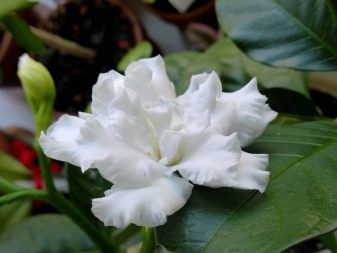

Types and varieties
In recent years, several types of tabernemontana have been bred, each of which has unique characteristics and properties.
Divarikata
The most common type, suitable for growing at home. Among the main characteristics:
- densely branching shoots;
- dark green leathery leaves;
- lush inflorescences, including up to 20 buds;
- flowers of cream and snow-white shades.
The petals of the buds feel rough to the touch, resemble corrugation. Flowers delight with a pleasant and rich aroma.
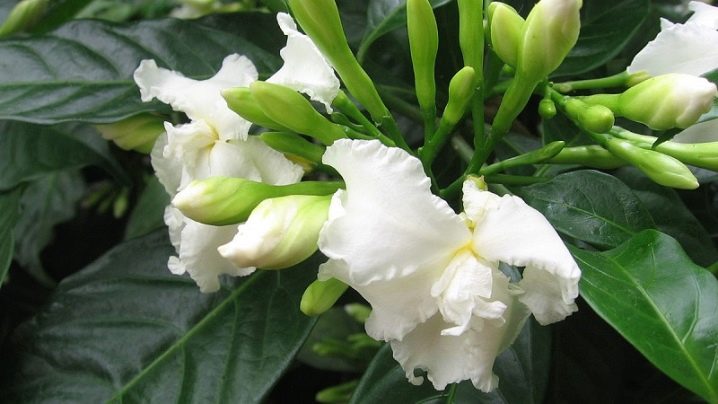
Elegans
The peculiarity of the culture is its resistance to external influences and temperature extremes. Elegance characteristics:
- long shoots;
- light green elongated leaves;
- large snow-white flowers;
- powerful inflorescences forming up to 10 buds.
The bush forms flowers with a weak and unobtrusive aroma.
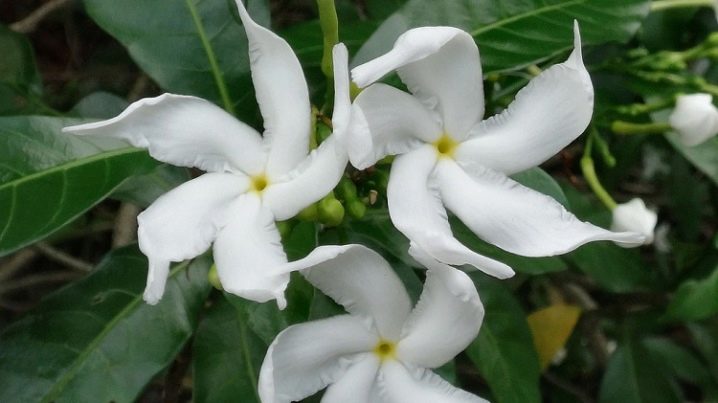
Crowned
Compact shrub with the following characteristics:
- strongly branching shoots;
- dark green leaves of an elongated oval shape;
- large inflorescences forming up to 15 flowers;
- small-sized buds are white.
The petals are non-double, pleasant to the touch.The flowers give out a pleasant sweet aroma as the buds open.
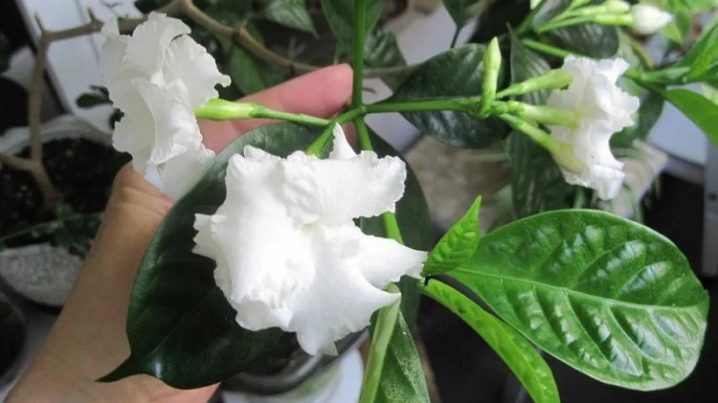
Sanango
The key feature of this species is dense and large leaves, the shape of which resembles more a circle than an oval. Other characteristics:
- small shoots;
- saturated green leaf plates;
- medium-sized white flowers.
The buds are distinguished by thin petals by which this species can be identified. The petals also curl along their entire length, retaining aroma and prolonging flowering.
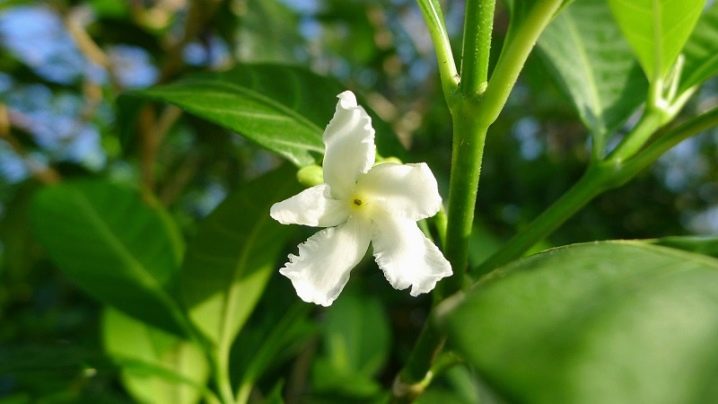
Other
Holst's tabernemontana deserves a special mention. The species is quite rare, the main parameters are:
- branched shoots;
- juicy green oval leaves;
- flowers of white or cream color, rather large.
The peculiarity of this subspecies lies in the unusual shape of the petals. They are small and curved "propellers" that form attractive buds that exude a pleasant and rich aroma.

Landing
It is recommended to plant tabernemontana in the form of seeds in pre-prepared soil. When choosing a land, you should give preference to acidic substrates, which can be purchased in specialized stores or prepared on your own.
It is better to plant seeds at a temperature of +18 degrees Celsius. After planting, the container should be covered with foil or protective glass, which will accelerate the survival rate of the seed. It should be noted right away that seedlings will develop slowly. On average, it takes up to 2-3 months to germinate seeds, and the plant will form the first buds only after 2 years.
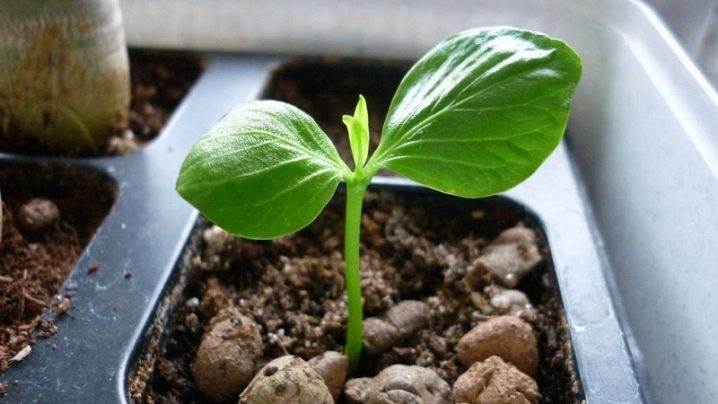
Care
Growing tabernemontana at home requires a responsible approach to plant care. Florists note that caring for a tabernemontana is practically no different from caring for a gardenia or oleander, but there are still a number of features that must be taken into account. The first step is to take care of timely watering and achieve optimal lighting for the bush. It is also worthwhile to provide for regular feeding, which will help strengthen the plant's immunity and prevent premature wilting of leaves and flowers.
The optimum temperature for growing tabernemontana is 17 to 22 degrees Celsius. Only under such conditions will the flower quickly take root in the ground and will actively grow. To achieve maximum light without burning the leaves and stems, it is recommended to place the pots on the west or southeast side. Lack of light will negatively affect the health of the bush, and it will begin to wither quickly.
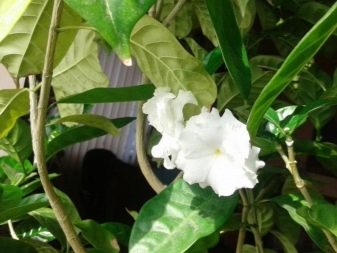
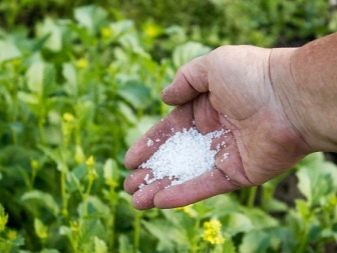
Watering
On average, the plant is watered at the optimum temperature 1-2 times a week. It is best to water at the beginning and end of the week to allow the soil to dry out. For watering the plant, it is recommended to use pre-settled warm water. In winter, the amount of water introduced into the ground can be reduced, since the bush practically does not grow. If excess moisture accumulates at the bottom of the pot, you should take care of its removal. Otherwise, there is a risk of root rot. Special attention should be paid to the humidity regime in the room. The indicator should be above average, since the bush prefers a rather humid climate.
You can increase the indicator by regularly spraying tabernemontana with a spray bottle. It will be enough to do the procedure 2-3 times a week to make the bush feel good.

Top dressing
The flower needs regular fertilization during active growth and flowering. First of all, you need to take care of the soil for the tabernemontana. The earth should be slightly acidic. Similar mixtures are sold in specialized flower shops. If necessary, you can prepare the substrate yourself. To do this, you will need to mix the following types of lands:
- coniferous;
- sod;
- sheet.
You will also need peat and coarse soil.All components must be taken in equal proportions to obtain a substrate with an ideal composition. Expanded clay of fine fraction or clay shards can act as a drainage layer. As for the dressing itself, the following options are generally preferred.
- Phosphate-potassium fertilizers. It is important that there is no lime in the composition of such complexes, so as not to harm the flower. It is recommended to fertilize tabernemontana 2-3 times a month, while the growing season of the flower passes.
- Lemon juice or citric acid. The plant feels good in acidified soils, therefore periodically (at least once a month) the soil needs to be fertilized with acid or lemon juice.
- Complexes for flowering plants. Similar formulations are sold in specialized stores. A good decision would be to buy complexes "Pocon", "Etisso", as well as drugs from foreign manufacturers.
- Nitrogen fertilizers. With their help, it will be possible to give the sheet plates a bright shine and make them more glossy. It is better to use the Emerald complex as a top dressing. Before use, you should carefully study the instructions.
Timely application of top dressing will accelerate the survival rate and growth of the flower, and will also help to achieve a lush flowering culture.

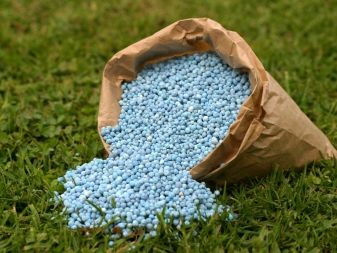
Pruning
Tabernemontana is unpretentious in care, the bush forms even a lush crown on its own, and additional pruning is not required for the plant. Growers advise trimming only shoots that are too long or twisted, which are noticeably knocked out of the total mass and look unattractive. It is also worth pruning:
- broken branches;
- inward growing stems;
- dried leaves.
Sometimes situations arise when the flower refuses to grow. In this case, pruning will help make the crown lush, it is only important to correctly approach the cutting of branches and shoots.
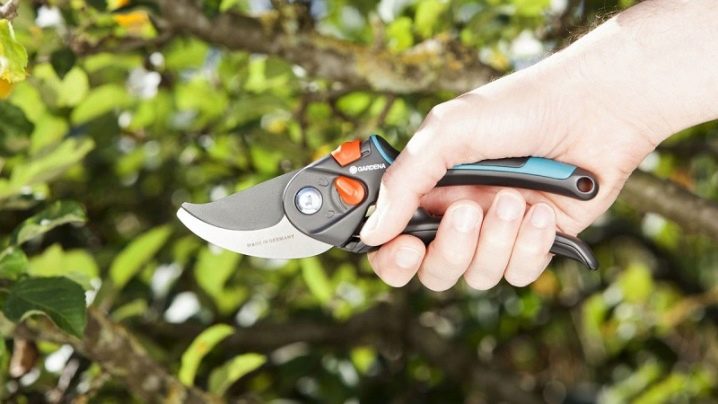
Wintering
Tabernemontana mainly rests in the winter months, since there is no way to provide it with full-fledged conditions for further growth and flowering. With the onset of frost, the flower is moved to a cool room with an air temperature of no higher than 15 degrees Celsius. Also, flower growers recommend reducing watering and canceling the application of any fertilizers for this time.
Reproduction
Tabernemontana is propagated by cuttings. At the very beginning of the procedure, the planting material is cut from the shoots of the mother plant, which have acquired a semi-lignified appearance. The maximum length of the cutting should not exceed 10 cm, preference should be given to shoots on which there are 2-3 pairs of strong leaf plates. The next stage is the germination of cuttings. To root the samples, they are placed in settled water or a mixture of peat and sand. To speed up the process of forming roots by cuttings, the cuts are treated with special compounds that stimulate the necessary processes.
It should be noted right away that the formation of roots is rather slow, and this stage can take 1.5-2 months even with the use of stimulants. After the required time has elapsed, the seedling should start growing, and then it can be transplanted into a previously prepared pot. With the right approach to reproduction and cultivation, the first flower buds will give out after a year.
The peculiarity of cuttings is that this method allows you to get a copy identical to the parent in a fairly short time.
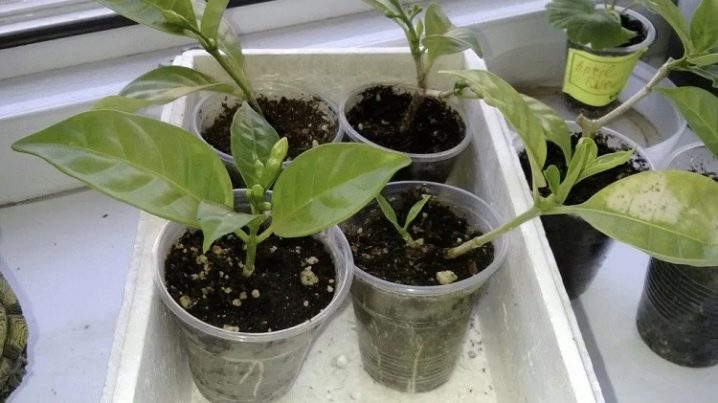
Diseases and pests
Tabernemontana has a fairly strong immune system. The bush does not impose special requirements for growing conditions; it is often not attacked by pests and diseases. However, this does not mean that problems cannot arise in the process of growing an indoor flower. Any mistakes in care can lead to the appearance of various diseases and the accumulation of insects.
It is possible to determine what is bad for a plant by a number of distinctive features.
- Yellow leaves. In this case, we can talk about the development of chlorosis - a serious disease that occurs when the composition of the soil is improper or when cold water is used to water the plant. If yellowed foliage is found, it is recommended to transplant the shrub into a pot with more suitable soil, as well as take care of proper watering.
- Sluggish and falling foliage. The disease is explained by the increased acidity of the soil in which the plant is located. Therefore, with a sharp wilting of the leaf plates, it is worth carefully examining the roots for the presence of root rot in order to prevent the development of the disease in the early stages. To cure a shrub is quite simple: just remove the affected areas and transplant the plant into healthy soil.
- Stretching shoots. Improper lighting can disrupt the growth of tabernemontana. To prevent overgrowth of the bush, it is worth moving the pot to a sunnier location.
- Falling flowers. Usually, this phenomenon occurs if the plant is too hot or the room is extremely humid. To prevent the flower from rotting, it is worth organizing regular airing of the room. In this case, it is necessary to ensure that there are no sharp gusts of wind.
- Delamination of sheet plates. The flower thus communicates a lack of nutrients. Ignoring the problem will lead to the development of various diseases, since the immunity of the bush will be quite low. Timely feeding and proper watering will help improve the situation.
- Formation of white droplets on the underside of the leaf. Various flower parasites are the cause of their appearance. If there are no signs of insects, it is worth adjusting the soil moisture and reducing watering.

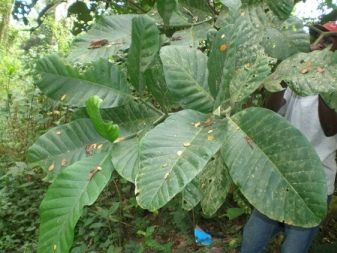
Various insects pose a particular danger to the flower. Often tabernemontane is harmed by aphids, scale insects, spider mites.
Timely treatment of the plant with special compounds will prevent the attacks of insects. It is also recommended to perform several prophylactic sprays with more gentle ingredients or folk remedies.
It is worth noting that foliage from a flower can begin to fall off during the process of plant renewal. Before proceeding with the treatment of the bush, it is worth making sure that there are signs of the disease. If the flower stops growing and the buds are no longer formed, it is worth considering replanting the plant. Perhaps this is not a disease: the roots are simply cramped in the existing conditions. As soon as the transplant is completed, the tabernemontana will start growing again.
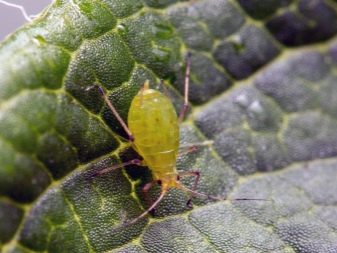
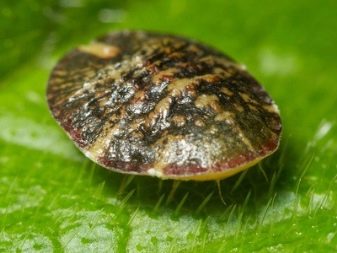































The comment was sent successfully.